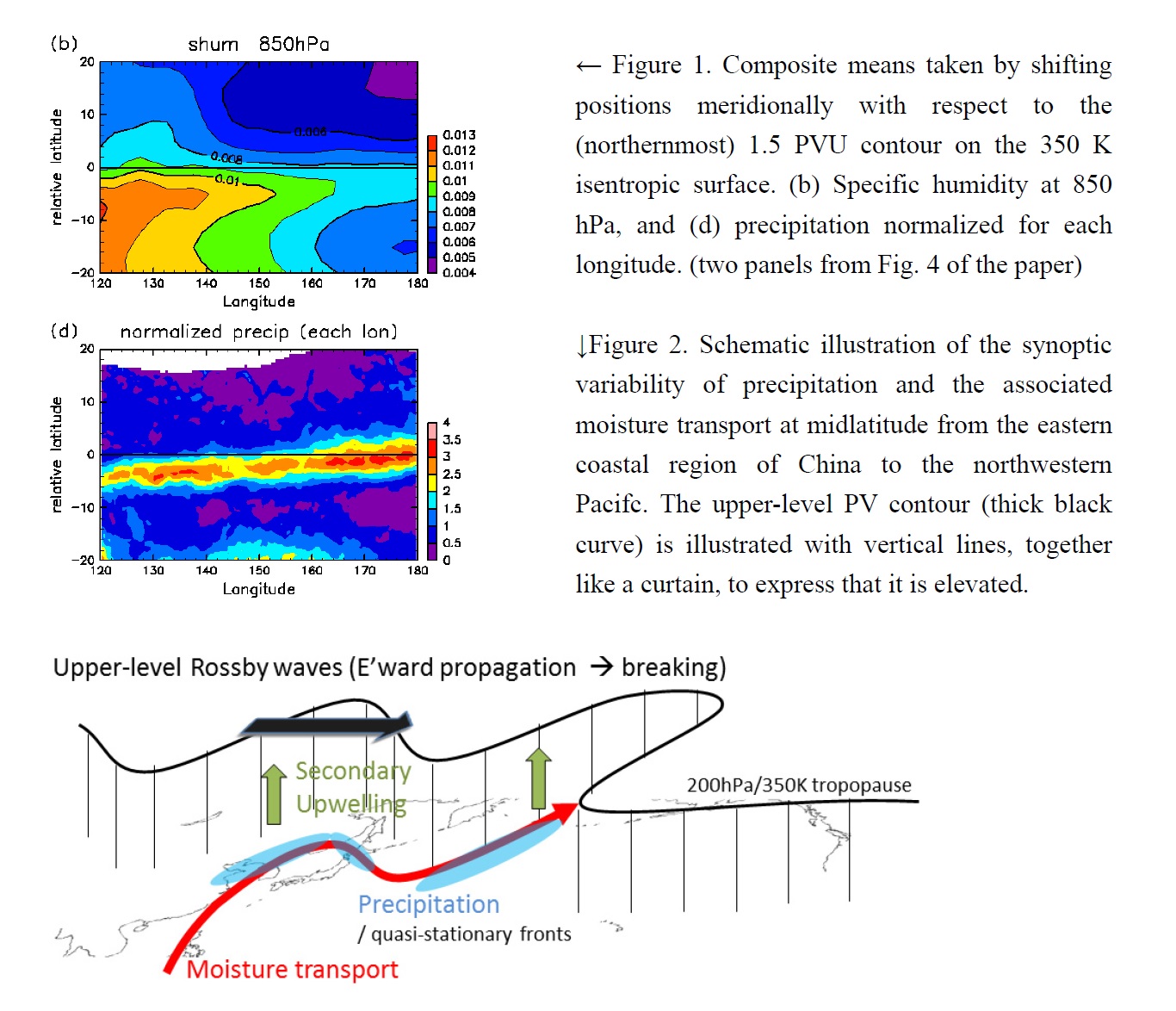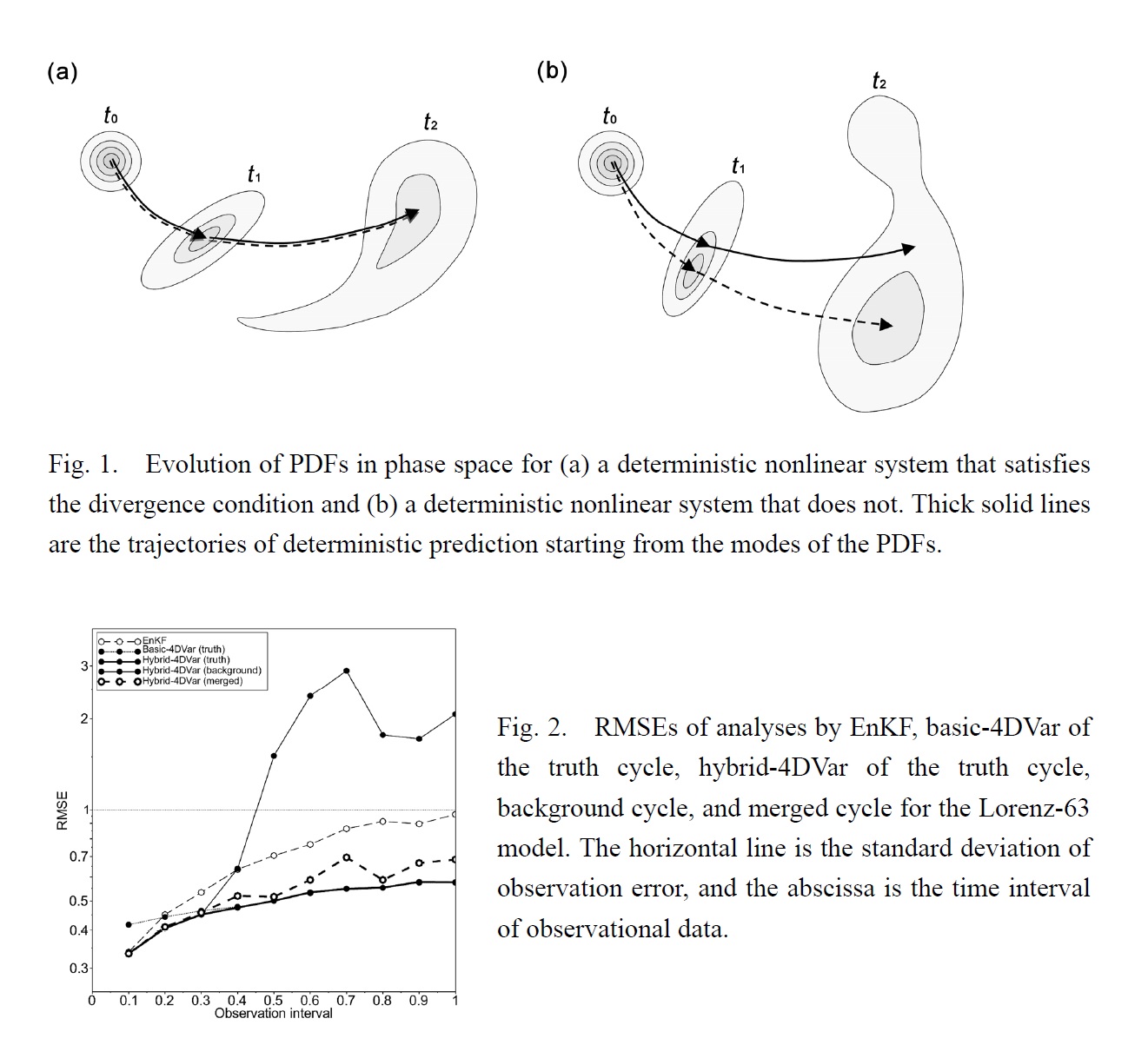Graphical Abstract
JMSJ, 2014, Vol. 92, No. 6 (December)
Articles
Fukui et al. (2014)
Fukui, S., T. Iwasaki, and W. Sha, 2014: An ensemble downscaling prediction experiment for medium-range forecasts of the daily mean surface temperature distribution over northeastern Japan during summer. J. Meteor. Soc. Japan, 92, 505-517.
http://dx.doi.org/10.2151/jmsj.2014-601
Graphical Abstract
Highlights:
- An ensemble dynamical downscaling system for medium-range forecasts of the detailed spatial distributions of the daily mean temperature was assessed using the Japan Meteorological Agency nonhydrostatic models with horizontal resolution of 25km and 5km.
- Ensemble mean downscaling forecasts can extract reliable signals with information about local circulations. The ensemble mean downscaling forecasts can reduce the errors compared to single downscaling forecasts and increase the spreads than the global forecasts used in the downscaling as initial and lateral boundary conditions.
- The predictability depends on the modes derived from an empirical orthogonal function (EOF) analysis of the observed daily mean surface temperature fields over northeastern Japan in summer. For the Yamase mode, the predictable period is 5 days (Fig. 1).
- The ensemble downscaling can predict the amplitudes of the EOF modes more realistically than the global model. For the Yamase mode, the ensemble downscaling predict 90 % of the amplitude, although the global model can predict 20% of the amplitude (Fig. 1).
Horinouchi (2014)
Horinouchi, T., 2014: Influence of upper tropospheric disturbances on the synoptic variability of precipitation and moisture transport over summertime East Asia and the northwestern Pacific. J. Meteor. Soc. Japan, 92, 519-541.
http://dx.doi.org/10.2151/jmsj.2014-602
Graphical Abstract
Highlights:
- By using satellite precipitation and reanalysis data, a clear relationship is found between upper tropospheric isentropic potential vorticity (PV) disturbances, surface precipitation, and lower tropospheric humidity through July and August from the eastern coastal region of China to the northwestern Pacific (Fig. 1); a precipitation band of several hundred kilometers wide and a thousand to several thousand kilometers long is formed frequently on the equatorward and low-PV side of the northernmost 1.5 PVU contours at 350 K (∼ 200 hPa).
- A thorough analysis reveals that this vertical association is due the downward forcing from the upper tropospheric Rossby waves; they exert positive forcing to low-level potential enstrophy, induce secondary circulation to initiate precipitation, and affect low-level moisture transport (Fig. 2).
- This study proposes a novel way to diagnose vertical interaction based on the quasi-geostrophic (QG) potential enstrophy defined using the QG PV in which boundary contributions are incorporated.
Noguchi et al. (2014)
Noguchi, S., H. Mukougawa, T. Hirooka, M. Taguchi, and S. Yoden, 2014: Month-to-month predictability variations of the winter-time stratospheric polar vortex in an operational one-month ensemble prediction system. J. Meteor. Soc. Japan, 92, 543-558.
http://dx.doi.org/10.2151/jmsj.2014-603
Graphical Abstract
Highlights:
- The predictability variation of the stratospheric polar vortex in the northern hemisphere winter is examined based on the systematic error and the ensemble spread using a seven-year archive of the operational ensemble one-month forecast dataset provided by the Japan Meteorological Agency.
- In early winter, the north pole temperature in the stratosphere has a significant warm bias due to the significant underestimation of the equatorward propagation of planetary waves in the upper stratosphere (Fig. 1).
- An upper bound of the predictable period of the north pole temperature is assessed by applying the logistic equation, which describes the evolution of small initial errors proposed by Lorenz, to the monthly averaged ensemble spread.
- The estimated predictable period in the stratosphere attains a maximum value of 35 days in early winter, gradually decreases with the seasonal march to 20 days in late winter, which is considerably longer than that in the troposphere (Fig. 2).
Chang et al. (2014)
Chang, C.-C., S.-C. Yang, and C. Keppenne, 2014: Applications of the mean recentering scheme to improve typhoon track prediction: A case study of Typhoon Nanmadol (2011). J. Meteor. Soc. Japan, 92, 559-584.
http://dx.doi.org/10.2151/jmsj.2014-604
Graphical Abstract
Highlights:
- Mean Recentering method (MRC) is proposed to improve the ensemble forecast with a poor performance, which suffers from the non-Gaussian distribution and not being able to capture the evolution of the nature. With the MRC method, this study focuses on improving the track prediction of Typhoon Nanmadol (2011), which had an abrupt change in its movement.
- A critical factor for the MRC method to have positive impact is the metric of selecting the best member. Cluster analysis (MRC_DA24c in Fig. 1) is suggested to determine the best member for operational purpose.
- With the MRC method, the Gaussianity of the ensemble forecast can be better maintained (figure 2).
- For operational purpose, although future information is required to determine the best member, the MRC method can provide an important tradeoff by adjusting the ensemble during the early developing stage of tropical cyclones.
Periáñez et al. (2014)
Periáñez, Á., T. H. Reich, and R. W. E. Potthast, 2014: Optimal localization for ensemble Kalman filter systems. J. Meteor. Soc. Japan, 92, 585-597.
http://dx.doi.org/10.2151/jmsj.2014-605
Graphical Abstract
Highlights:
- In ensemble Kalman filter methods, localization is applied for both avoiding the spurious correlations of distant observations and increasing the effective size of the ensemble space. The procedure is essential in order to provide quality assimilation in large systems; e.g., severe localization can cause imbalances that impact negatively on the accuracy of the analysis.
- We want to understand the fundamental properties of localized ensemble methods and to investigate an optimal localization formula that minimizes the analysis error. The theoretical expression of the optimal localization radius that we derive in this work depends on the observation error, the density of measurements, and the approximation error, i.e., the error that comes from working in the ensemble space.
- The mathematical results are tested with two numerical simulations using a toy model. We demonstrate that observations with different observation error or density need different localization length scales. The numerical results demonstrate the validity of the analytical results derived in our first parts.
Tsuyuki (2014)
Tsuyuki, T., 2014: Deterministic predictability of the most probable state and reformulation of variational data assimilation. J. Meteor. Soc. Japan, 92, 599-622.
http://dx.doi.org/10.2151/jmsj.2014-606
Graphical Abstract
Highlights:
- Conditions for the forecast state starting from the mode of a PDF of the state variables to remain sufficiently close to the mode of the PDF at forecast time are derived under assumption of a small forecast error.
- A new formulation of 4DVar is presented, which reveals that a non-Gaussian prior PDF which evolves according to the Liouville equation is implicitly used in 4DVar.
- Results from data assimilation experiments with toy models demonstrate that 4DVar cycles with some modifications outperform EnKF cycles in terms of the accuracy of analysis in strong nonlinearity as well as in weak nonlinearity.
Kunii et al. (2014)
Kunii, M., 2014: The 1000-member ensemble Kalman filtering with the JMA nonhydrostatic mesoscale model on the K computer. J. Meteor. Soc. Japan, 92, 623-633.
http://dx.doi.org/10.2151/jmsj.2014-607
Graphical Abstract
Highlights:
- The influence of sampling noise on background error covariance was estimated by running the 1000-member EnKF with the JMA nonhydrostatic mesoscale model on the K computer.
- The background error covariance estimated from 1000 ensemble members contained negligible sampling noise even at distant locations without covariance localization (Fig. 1).
- For the case in the current study, an ensemble size of 500 would be large enough to approximate the error covariance under the configuration with a horizontal resolution of 15 km (Fig.2).













